warning Oldsmobile Aurora 1997 Owner's Manuals
[x] Cancel search | Manufacturer: OLDSMOBILE, Model Year: 1997, Model line: Aurora, Model: Oldsmobile Aurora 1997Pages: 404, PDF Size: 20.75 MB
Page 5 of 404
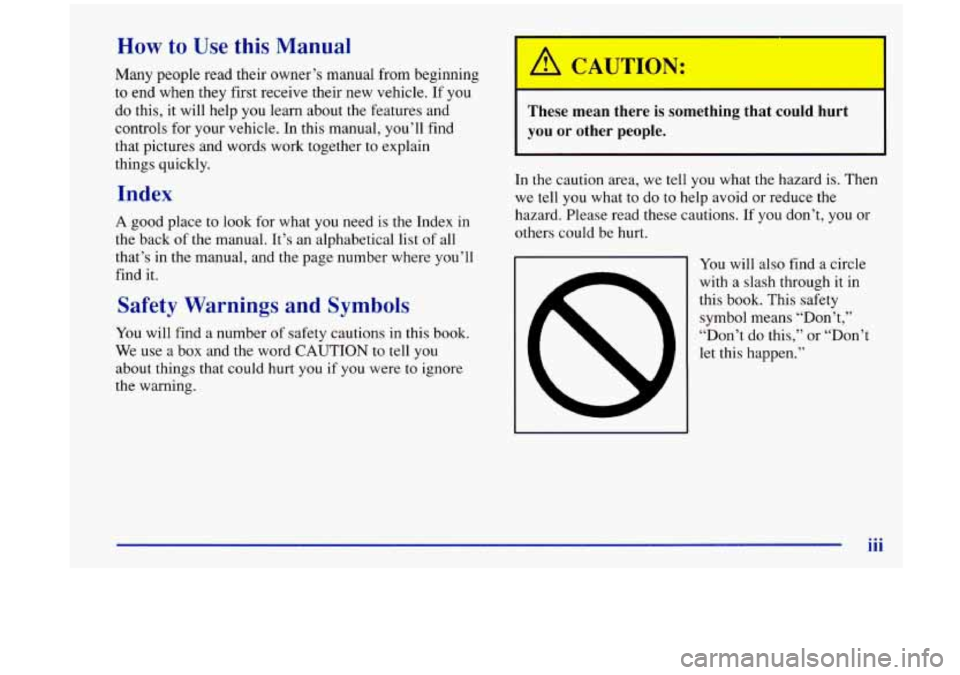
How to Use this Manual
Many people read their owner’s manual from beginning
to end when they first receive their new vehicle. If you
do this, it will help you learn about the features and
controls for your vehicle. In this manual, you’ll find
that pictures and words work together to explain
things quickly.
Index
A good place to look for what you need is the Index in
the back
of the manual. It’s an alphabetical list of all
that’s in the manual, and the page number where you’ll
find it.
Safety Warnings and Symbols
You will find a number of safety cautions in this book.
We use a box and the word CAUTION to tell you
about things that could hurt
you if you were to ignore
the warning.
These mean there is something that could hurt
you or other people.
In the caution area, we tell you what the hazard is. Then
we tell you what to do to help avoid or reduce the
hazard. Please read these cautions. If you don’t, you
or
others could be hurt.
dl You will also find a circle
with a slash through it in
this book. This safety
symbol means “Don’t,’’
“Don’t do this,” or “Don’t
let this happen.”
iii
Page 6 of 404

Vehicle Damage Warnings
Also in this book you will find these notices:
I NOTICE:
These mean there is something that could
damage
your vehicle.
In the notice area, we tell you about something that can
damage your vehicle. Many times, this damage would
not be covered by your warranty, and it could be costly.
But
the notice will tell you what to do to help avoid
the damage.
When you read other manuals, you might see CAUTION and NOTICE warnings in different colors or in
different words.
You’ll also see warning labels on your vehicle. They use
the same words, CAUTION or NOTICE.
iv
Page 7 of 404
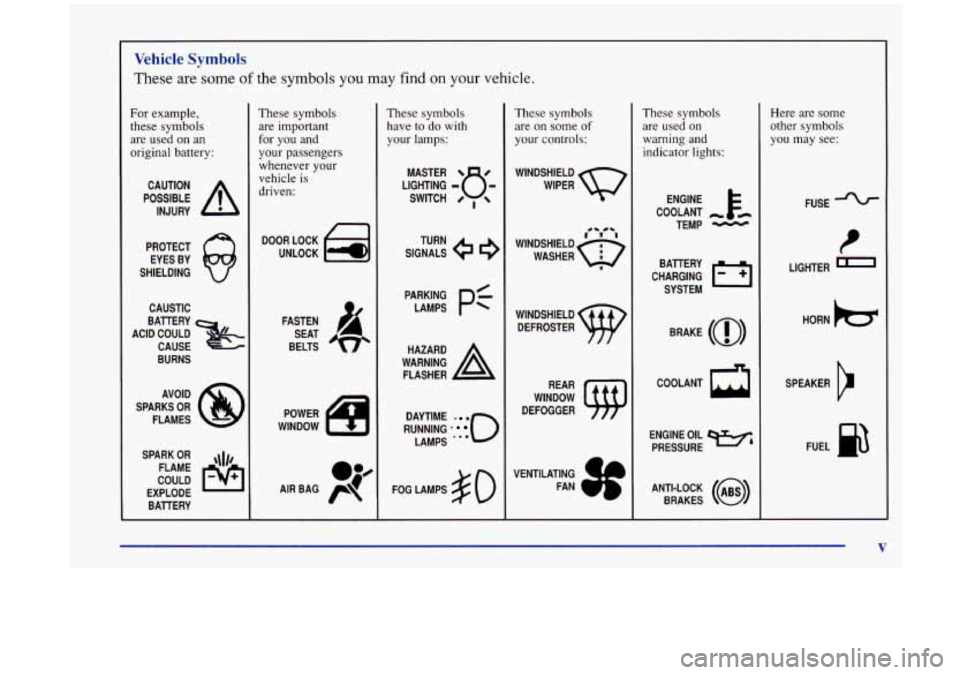
Vehicle Symbols
These are some of the symbols you may find on your vehicle.
For example, these symbols are used on
an
original battery:
POSSIBLE A
CAUTION
INJURY
PROTECT EYES BY
SHIELDING
CAUSTIC
BURNS
SPARK OR
,\I/,
COULD FLAME
EXPLODE BATTERY
These symbols are important
for you and
your passengers
whenever your
vehicle
is
driven:
DOOR LOCK
UNLOCK
FASTEN SEAT
BELTS
These symbols have to
do with
your lamps:
SIGNALS e e
TURN
WARNING
A
HAZARD
FLASHER
RUNNING
* 0
DAYTIME - a
LAMPS .**
FOG LAMPS # 0
These symbols
are on some
of
your controls:
WINDSHIELD
DEFROSTER
VENTILATING FAN
(
These symbols are used on
warning and
indicator lights:
ENGINE t
COOLANT - t-
TEMP -
CHARGING BATTERY
SYSTEM
BRAKE
(a)
COOLANT a
ENGINE OIL w,
PRESSURE
ANTI-LOCK
(@)
BRAKES
Here are some other symbols
you may see:
FUSE
P
LIGHTER n
HORN )tr
SPEAKER
b
FUEL m
Page 57 of 404
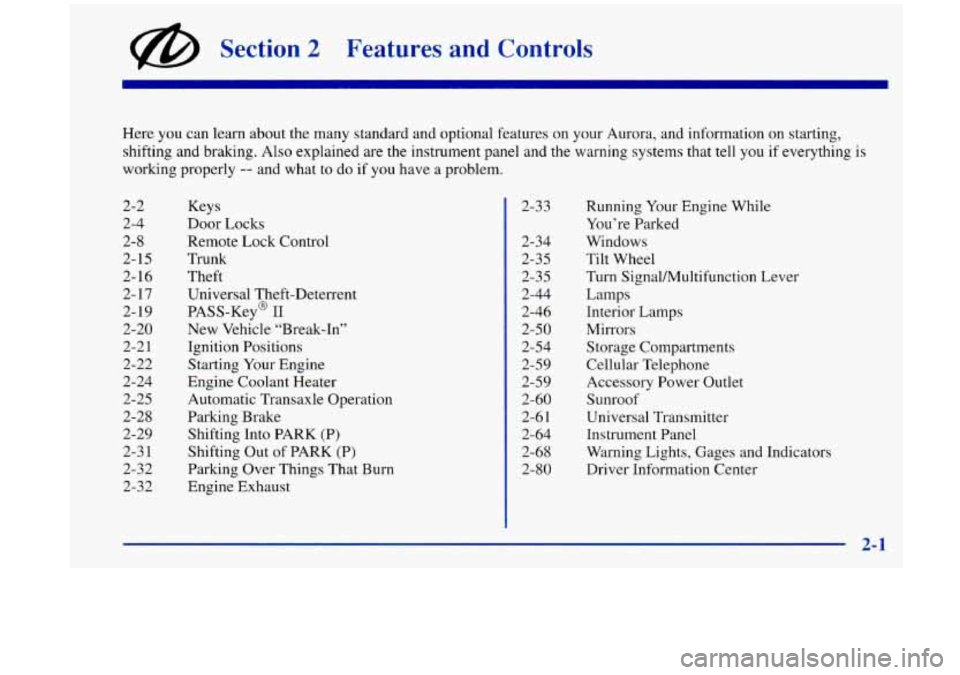
@ Section 2 Features and Controls
2-2
2-4 2-8
2- 15
2-16
2- 17
2- 19
2-20
2-2 1
2-22
2-24
2-25
2-28
2-29
2-3 1
2-32
2-32 2-3
3
2-34
2-3
5
2-35
2-44
2-46
2-50
2-54
2-59
2-59
2-60
2-6
1
2-64
2-68 2-80
Here
you can learn about the many standard and optional features on your Aurora, and information on starting,
shifting and braking. Also explained
are the instrument panel and the warning systems that tell you if everything is
working properly -- and what to do if you have a problem.
Keys
Door Locks
Remote Lock Control
Trunk
Theft
Universal Theft-Deterrent
PASS-Key@
I1
New Vehicle “Break-In”
Ignition Positions
Starting Your Engine
Engine Coolant Heater Automatic Transaxle Operation
Parking Brake Shifting Into PARK
(P)
Shifting Out of PARK (P)
Parking Over Things That Burn
Engine Exhaust Running
Your Engine While
You’re Parked
Windows Tilt Wheel
Turn SignaUMultifunction Lever Lamps
Interior Lamps
Mirrors Storage Compartments
Cellular Telephone
Accessory Power Outlet Sunroof
Universal Transmitter
Instrument Panel
Warning Lights, Gages and Indicators
Driver Information Center
2-1
Page 77 of 404
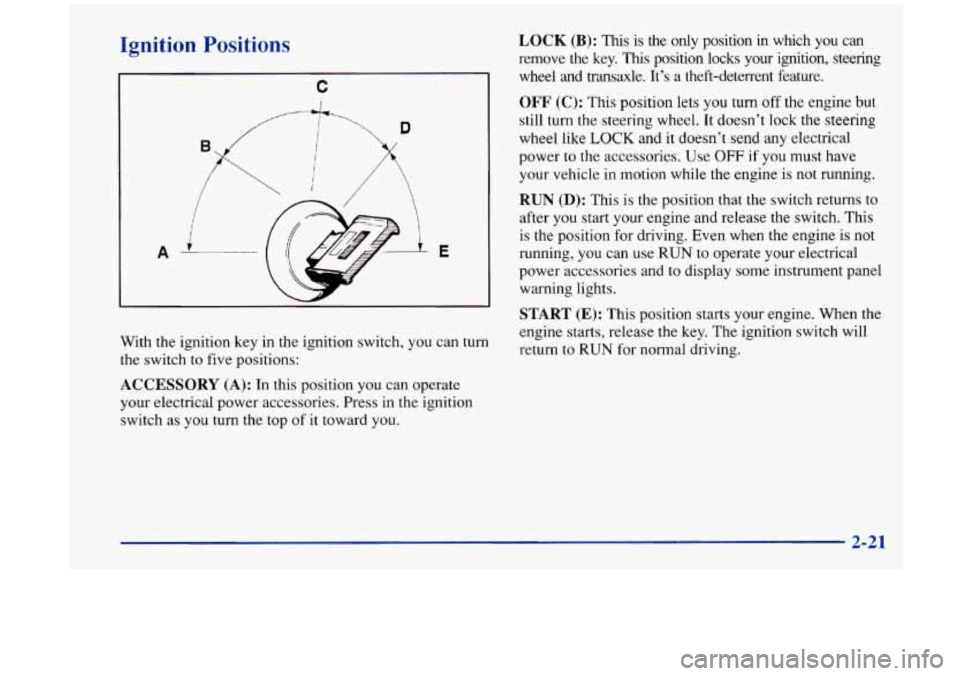
Ignition Positions
C
D
1 I
A E
With the ignition key in the ignition switch, you can turn
the switch to five positions:
LOCK (B): This is the only position in which you can
remove the key. This position locks your ignition, steering
wheel and transaxle. It’s a theft-deterrent feature.
OFF (C): This position lets you turn off the engine but
still turn the steering wheel. It doesn’t lock the steering
wheel like
LOCK and it doesn’t send any electrical
power to the accessories. Use
OFF if you must have
your vehicle in motion while the engine is not running.
RUN (D): This is the position that the switch returns to
after you start your engine and release the switch. This
is the position for driving. Even when the engine
is not
running, you can use
RUN to operate your electrical
power accessories and to display some instrument panel
warning lights.
START (E): This position starts your engine. When the
engine starts, release the key. The ignition switch will
return to
RUN for normal driving.
ACCESSORY (A): In this position you can operate
your electrical power accessories. Press in the ignition
switch as you turn the top of it toward you.
2-21
Page 78 of 404
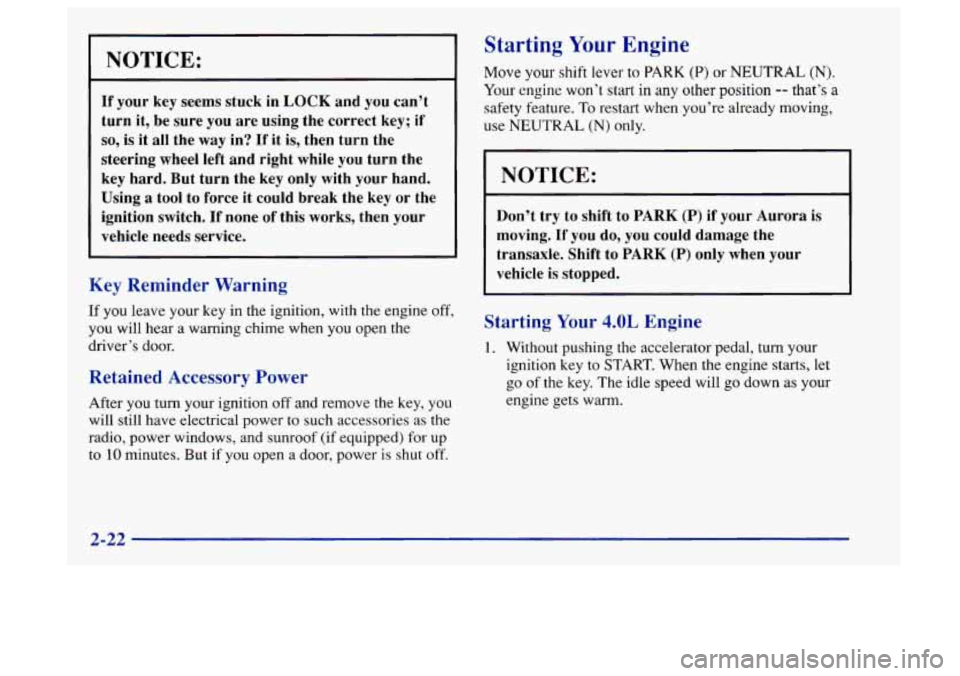
NOTICE:
If your key seems stuck in LOCK and you can’t
turn it, be sure you are using the correct key; if
so, is it all the way in? If it is, then turn the
steering wheel left and right while you turn the
key hard. But turn the key only with your hand.
Using
a tool to force it could break the key or the
ignition switch. If none
of this works, then your
vehicle needs service.
Key Reminder Warning
If you leave your key in the ignition, with the engine off,
you will hear a warning chime when you open the
driver’s door.
Retained Accessory Power
After you turn your ignition off and remove the key, you
will still have electrical power
to such accessories as the
radio, power windows, and sunroof
(if equipped) for up
to 10 minutes. But if you open a door, power is shut off.
Starting Your Engine
Move your shift lever tu PARK (P) or NEUTRAL (N).
Your engine won’t start in any other position -- that’s a
safety feature. To restart when you’re already moving,
use NEUTRAL
(N) only.
I NOTICE:
Don’t try to shift to PARK (P) if your Aurora is
moving. If you do, you could damage the
transaxle. Shift to PARK
(P) only when your
vehicle is stopped.
Starting Your 4.0L Engine
1. Without pushing the accelerator pedal, turn your
ignition key to START. When the engine starts, let
go of the key.
The idle speed will go down as your
engine gets warm.
2-22
Page 93 of 404
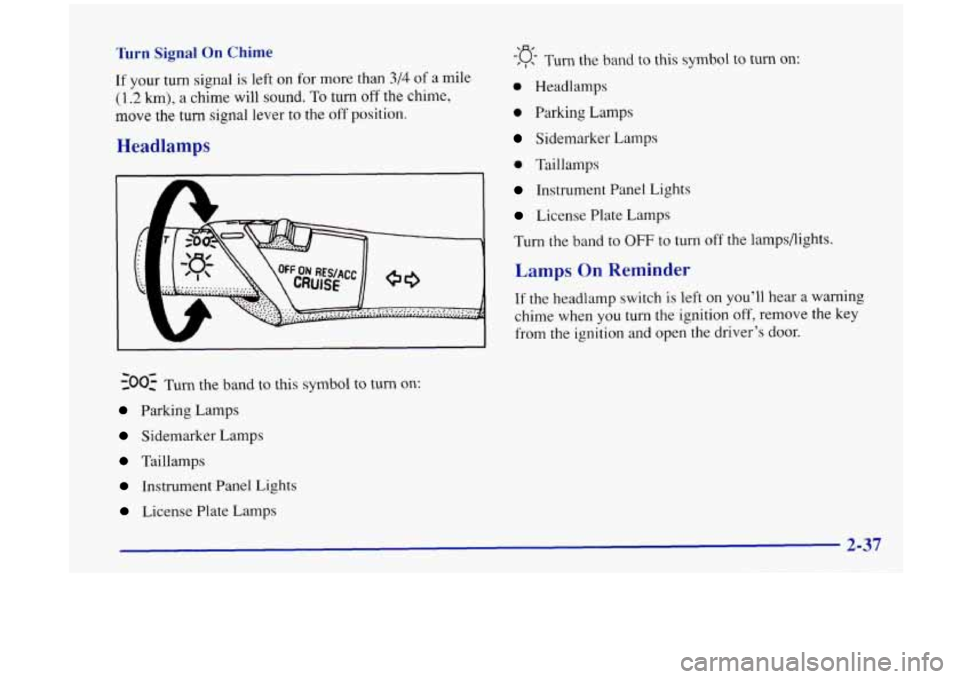
Turn Signal On Chime
If your turn signal is left on for more than 3/4 of a mile
(1.2 km), a chime will sound. To turn off the chime,
move the turn signal lever to the off position.
Headlamps
Turn the band to this symbol to turn on:
Parking Lamps
Sidemarker Lamps
Taillamps
Instrument Panel Lights
License Plate Lamps
-‘Q , , Turn the band to this symbol to turn on:
0 Headlamps
0 Parking Lamps
Sidemarker Lamps
0 Taillamps
Instrument Panel Lights
License Plate Lamps
Turn the band to
OFF to turn off the lampsflights.
Lamps On Reminder
If the headlamp switch is left on you’ll hear a warning
chime when you turn the ignition
off, remove the key
from the ignition and open the driver’s door.
Page 121 of 404
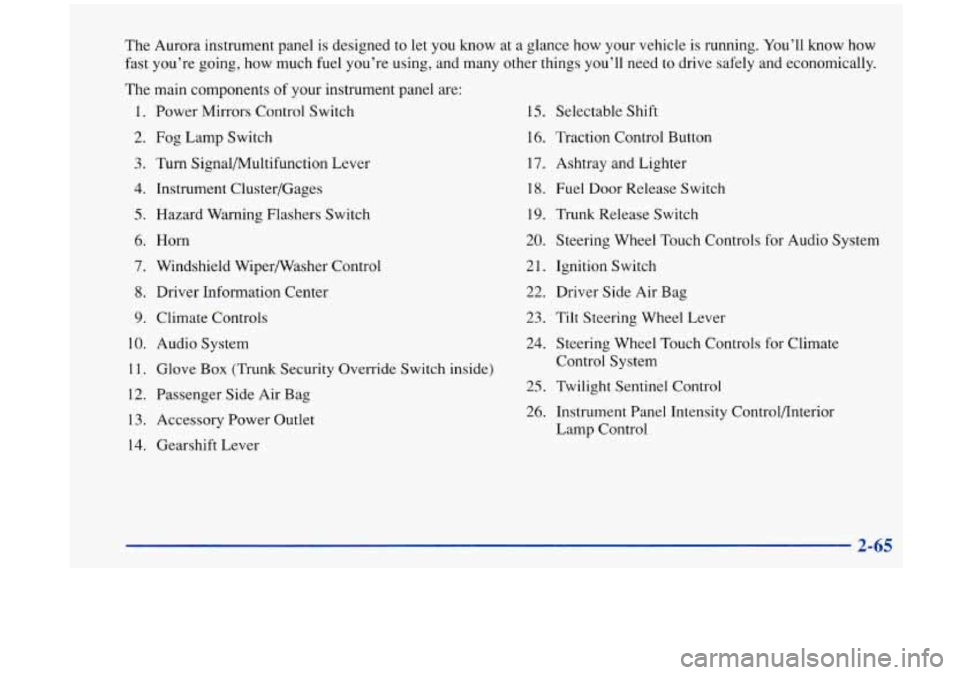
The Aurora instrument panel is designed to let you know at a glance how your vehicle is running. You’ll know how
fast you’re going, how much fuel you’re using, and many other things you’ll need to drive safely and economically.
The main components
of your instrument panel are:
1. Power Mirrors Control Switch
2.
Fog Lamp Switch
3. Turn Signal/Multifunction Lever
4. Instrument Cluster/Gages
5. Hazard Warning Flashers Switch
6.
Horn
7. Windshield Wipermasher Control
8. Driver Information Center
9. Climate Controls
10. Audio System
11. Glove Box (Trunk Security Override Switch inside)
12. Passenger Side Air Bag
13. Accessory Power Outlet
14. Gearshift Lever
15. Selectable Shift
16. Traction Control Button
17. Ashtray and Lighter
18. Fuel Door Release Switch
19. Trunk Release Switch
20. Steering Wheel Touch Controls for Audio System
21. Ignition Switch
22. Driver Side Air Bag
23. Tilt Steering Wheel Lever
24. Steering Wheel Touch Controls for Climate
Control System
25. Twilight Sentinel Control
26. Instrument Panel Intensity Control/Interior
Lamp Control
Page 122 of 404
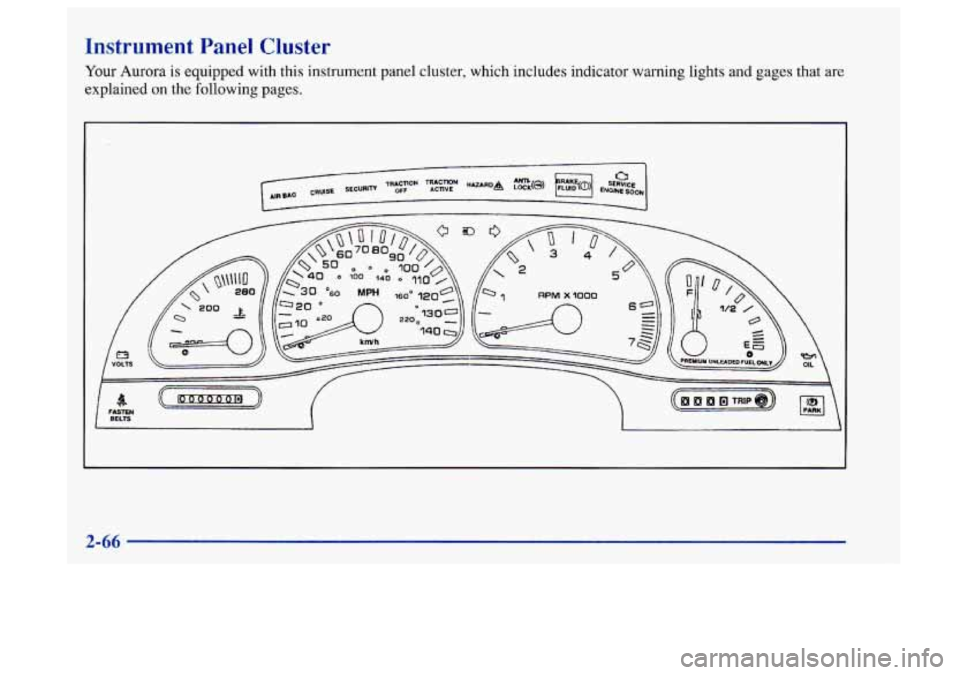
Instrument Panel Cluster
Your Aurora is equipped with this instrument panel cluster, which includes indicator warning lights and gages that are
explained on the following pages.
2-66
Page 124 of 404
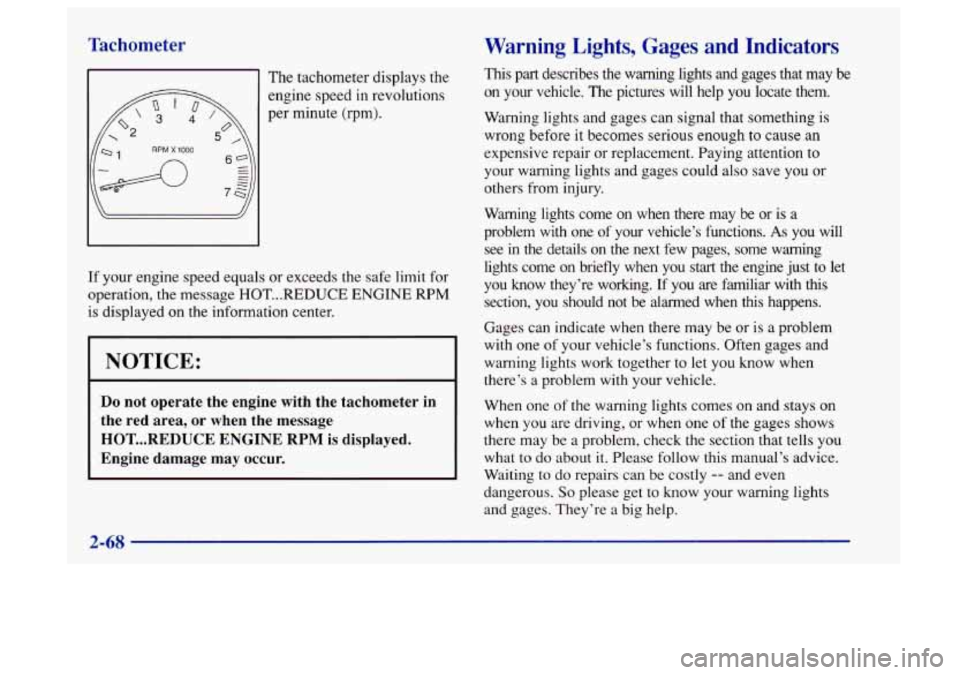
Tachometer
The tachometer displays the
engine speed in revolutions
per minute (rpm).
If your engine speed equals or exceeds the safe limit for
operation, the message HOT
... REDUCE ENGINE RPM
is displayed on the information center.
I NOTICE: I
Do not operate the engine with the tachometer in
the red area,
or when the message
HOT. ..REDUCE ENGINE RPM is displayed.
Engine damage may occur.
Warning Lights, Gages and Indicators
This part describes the warning lights and gages that may be
on your vehicle. The pictures will help you locate them.
Warning lights and gages can signal that something
is
wrong before it becomes serious enough to cause an
expensive repair or replacement. Paying attention to
your warning lights and gages could also save you
or
others from injury.
Warning lights come on when there may be or is a
problem with one of your vehicle’s functions.
As you will
see
in the details on the next few pages, some warning
lights come on briefly when
you start the engine just to let
you know they’re working.
If you are familiar with this
section, you should not be alarmed when this happens.
Gages can indicate when there may be or
is a problem
with one of your vehicle’s functions. Often gages and
warning lights work together to let you know when
there’s
a problem with your vehicle.
When one
of the warning lights comes on and stays on
when you are driving, or when one
of the gages shows
there may be a problem, check the section that tells you
what to
do about it. Please follow this manual’s advice.
Waiting to
do repairs can be costly -- and even
dangerous.
So please get to know your warning lights
and gages. They’re
a big help.